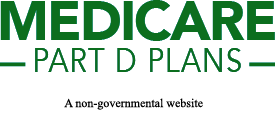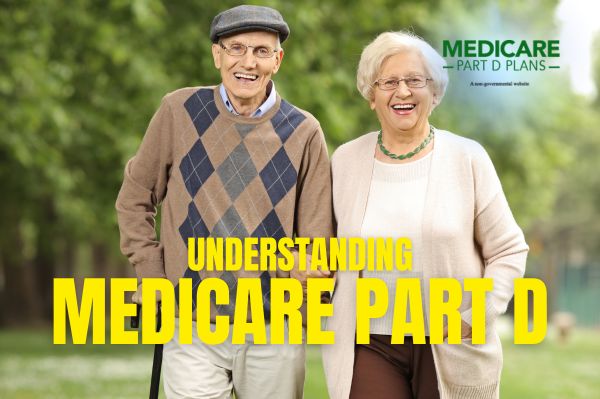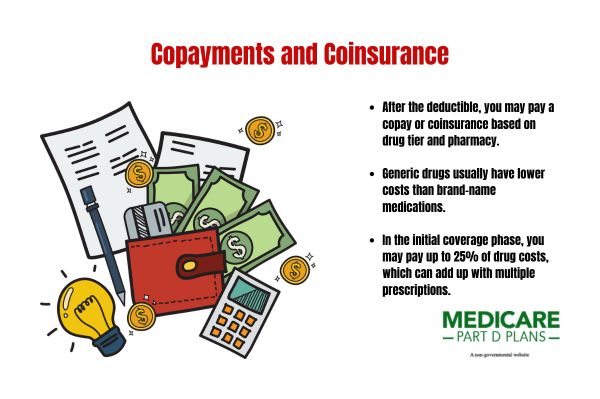Find a Medicare Part D prescription drug plan

Medicare Part D
Prescription Drug Coverage 2026
Cost of Medicare Part D
Medicare Part D costs, such as premiums, deductibles, and copayments, will likely be crucial to understand. Knowing these expenses might help you manage your drug costs effectively. This article breaks down each cost component so you can plan your healthcare expenses better.
Key Takeaways
- Medicare Part D will likely provide optional prescription drug coverage for Medicare beneficiaries, with costs that might include premiums, deductibles, and out-of-pocket expenses.
- An out-of-pocket maximum of about $2,000 may be implemented, potentially offering financial relief and access to catastrophic coverage for those with high drug costs.
- The Inflation Reduction Act might eliminate the coverage gap and may introduce new subsidies, possibly making prescription drugs more affordable for Medicare Part D enrollees.
Understanding Medicare Part D
Medicare Part D is an optional program that could provide prescription drug coverage for those enrolled in Medicare. Unlike Original Medicare, which covers hospital and medical insurance (Parts A and B), Medicare Part D will likely target outpatient prescription drugs. This coverage may be crucial for managing drug costs, especially for those who rely on regular medication to maintain their health.
Understanding Medicare Part D could be critical for managing healthcare expenses effectively. Rising costs might make it essential to know how to navigate your Medicare drug plan, such as recognizing out-of-pocket expenses like premiums, deductibles, and copayments, to help avoid unexpected financial strain.
A clear understanding of Medicare Part D and its potential costs will likely allow beneficiaries to make informed healthcare decisions. Knowing which medications may be covered, the potential costs, and available support could help optimize drug coverage and possibly ensure the best possible care.
Components of Medicare Part D Costs
Knowing the various components of Medicare Part D costs will likely be key to managing healthcare expenses effectively. These might include monthly premiums, annual deductibles, and out-of-pocket expenses like copayments and coinsurance.
These elements collectively determine the total out-of-pocket costs for beneficiaries, which may vary widely depending on the chosen Medicare Part D plan.
Monthly Premiums
Monthly premiums could form a significant part of Medicare Part D costs. In recent years, the national base beneficiary premium was around $36.78, but the actual amount may vary based on the selected plan and income level. Some plans might offer lower premiums in exchange for higher out-of-pocket costs elsewhere.
The Income-Related Monthly Adjustment Amount (IRMAA) might increase premiums if your income exceeds certain thresholds, ranging from around $0 to over $81 per month. Understanding how these premiums and plan premium calculations could be influenced by changes in monthly payments is crucial.
Annual Deductible
The annual deductible may be another key component of Medicare Part D costs. The maximum deductible may be capped at around $590, though some plans may offer no deductible. This should be paid out of pocket before your plan covers prescription costs, as it could directly impact initial expenses for medications.
Once the annual deductible has been met, your plan’s drug coverage begins, potentially reducing out-of-pocket costs for prescriptions. Some plans may offer lower deductibles but higher premiums, so evaluating your healthcare needs and budget is essential to select the best plan.
Copayments and Coinsurance
After meeting the deductible, you might pay a fixed copayment or a percentage of the drug cost, called coinsurance. The amount may vary depending on the medication tier and pharmacy. For example, paying generic drugs might have lower copayments than brand-name drugs.
During the initial coverage phase, beneficiaries may pay up to 25% of prescription drug costs, and the plan may cover the remaining 65%. This cost-sharing structure might help manage expenses, but costs could add up, especially if you require multiple or high-cost medications.
Out-of-Pocket Maximums and Catastrophic Coverage
An out-of-pocket spending cap of about $2,000 for Medicare Part D enrollees might be implemented. This potential change could provide financial relief, especially for those with high prescription drug costs and total drug costs.
Once your out-of-pocket spending on covered Part D drugs reaches the set cap in a calendar year, you may automatically qualify for catastrophic coverage. In this phase, you might not need to pay out-of-pocket for most covered Part D drugs for the rest of the year, possibly benefiting those with high medication costs.
Enrollees who don’t receive financial assistance may save even more, averaging about $1,100 per individual in 2024. This potential reduction in out-of-pocket spending could significantly impact beneficiaries’ financial well-being, possibly ensuring they could afford necessary medications without undue stress.
Income-Related Monthly Adjustment Amount (IRMAA)
The Income-Related Monthly Adjustment Amount (IRMAA) may be an extra charge that might raise Medicare Part D costs for higher-income beneficiaries.
Based on income reported two years prior, 2025 assessments will likely use 2023 tax returns. Significant income fluctuations could potentially trigger a higher IRMAA charge.
Beneficiaries should pay Part D IRMAA directly to Medicare, not through their plan or employer. If you believe your income was miscalculated or your circumstances have changed, you may request a new determination or appeal the IRMAA decision.
Knowing how IRMAA could affect your costs and understanding your rights to challenge these charges will likely be crucial for managing Medicare expenses.
The Potential Impact of the Inflation Reduction Act
The Inflation Reduction Act may introduce several changes to Medicare Part D that could help reduce beneficiary costs. This might include the elimination of the coverage gap, or doughnut hole, so beneficiaries may no longer face a period of higher out-of-pocket drug costs.
The Act may also eliminate cost-sharing in the catastrophic coverage phase, meaning beneficiaries might not have out-of-pocket costs once they reach the catastrophic threshold limit.
Additionally, the Act may introduce a subsidy for selected drugs, possibly offering Part D sponsors a government subsidy equal to about 10% of negotiated drug prices. These potential changes will likely aim to provide financial relief and possibly make prescription drugs more affordable for enrollees.
See plans in your area instantly!
Advertisement
Medicare Prescription Payment Plan
The Medicare Prescription Payment Plan might be a new initiative that could help beneficiaries manage out-of-pocket drug costs. It may allow enrollees to pay certain expenses through capped monthly amounts rather than one-time payments, possibly making budgeting easier.
Guidelines for the Medicare Prescription Payment Plan will likely focus on identifying beneficiaries who may benefit. This initiative could be particularly valuable for those facing high out-of-pocket medication costs, possibly offering a more manageable and predictable way to handle expenses.
Late Enrollment Penalty
The late enrollment penalty for Medicare Part D may be as follows:
- It will likely be a permanent addition to your monthly premium if you don’t sign up when first eligible and go without creditable drug coverage for 63 or more days.
- The penalty may be calculated at around 1% of the national base beneficiary premium for each month without coverage.
- For example, a 14-month delay could result in a 14% penalty.
This penalty will likely permanent, meaning you may need to pay it as long as you have Medicare drug coverage. Understanding this penalty and enrolling in a Medicare Part D plan during your Initial Enrollment Period could help avoid these additional costs.
Tips for Reducing Medicare Part D Costs
Several strategies could potentially reduce Medicare Part D costs. Opting for generic medications instead of brand-name drugs may lead to significant savings. Generic medications may be cheaper and effectively manage health conditions.
Using preferred pharmacies within your Medicare Part D plan may also reduce certain copayment amounts. Additionally, enrolling in assistance programs like the Extra Help program might lower out-of-pocket expenses for those who qualify based on income.
Exploring these options and participating in medication therapy management services could optimize your medication regimen and reduce costs in most cases.
Choosing the Right Medicare Part D Plan
Choosing the right Medicare Part D plan will likely be crucial for managing prescription drug costs effectively. Regularly reviewing and comparing available plans could help you find lower premiums and better coverage options tailored to your medication needs. Our website is a great resource to simplify this process.
Individualized assistance for selecting a Medicare plan will likely be available through local State Health Insurance Assistance Programs (SHIP). These programs provide free, unbiased help to beneficiaries.
Understanding your health care needs and comparing different Medicare Part D plans could potentially lead to savings and better drug coverage. This proactive approach will likely ensure you select a plan that fits your budget and provide the necessary medication coverage.
Find a Plan and Enroll Online Yourself!
Advertisement
Summary
Understanding the potential costs associated with Medicare Part D will likely be essential for managing your healthcare expenses effectively. By breaking down the components like premiums, deductibles, copayments, and the potential impact of legislative changes, you could make informed decisions about your drug coverage.
The potential introduction of out-of-pocket maximums and the Medicare Prescription Payment Plan could offer additional support to help manage costs.
Selecting the right Medicare Part D plan and exploring ways to potentially reduce costs, such as opting for generic medications and utilizing preferred pharmacies, may lead to significant savings. Stay informed, review your options regularly, and take advantage of available resources to ensure you are getting the best possible coverage for your needs.
Frequently Asked Questions
What is Medicare Part D and why is it important?
Medicare Part D is a program that offers prescription drug coverage to Medicare beneficiaries, potentially alleviating the financial burden of outpatient medication costs. This coverage could help ensure access to necessary medications, likely making it an important resource for many.
How is the monthly premium for Medicare Part D determined?
The monthly premium for Medicare Part D will likely be determined by the specific plan selected and the individual’s income level. While the national base beneficiary premium may be set around $36.78, actual premiums might increase based on additional income adjustments.
What is the significance of the out-of-pocket spending cap?
The out-of-pocket spending cap, which may be set around $2,000, could provide crucial financial relief for Medicare Part D enrollees. Once this limit is reached, beneficiaries might not incur additional out-of-pocket costs for most covered medications for the remainder of the year.
This policy could help protect individuals from exorbitant drug costs and enhance access to necessary medications.
How might the Inflation Reduction Act affect Medicare Part D costs?
The Inflation Reduction Act could potentially lower Medicare Part D costs by eliminating the coverage gap and removing cost-sharing in the catastrophic phase, while it may also implement new subsidies for certain drugs. This legislation will likely aim to make prescription medications more affordable for enrollees.
What is the Medicare Prescription Payment Plan and how does it help?
The Medicare Prescription Payment Plan could potentially simplify budgeting for beneficiaries by offering out-of-pocket drug costs to be paid in capped monthly amounts rather than as one-time payments. This structure may help ensure manageable expenses for prescription medications under all Medicare Part D plans.
Begin Choosing your plan
Advertisement
ZRN Health & Financial Services, LLC, a Texas limited liability company.


